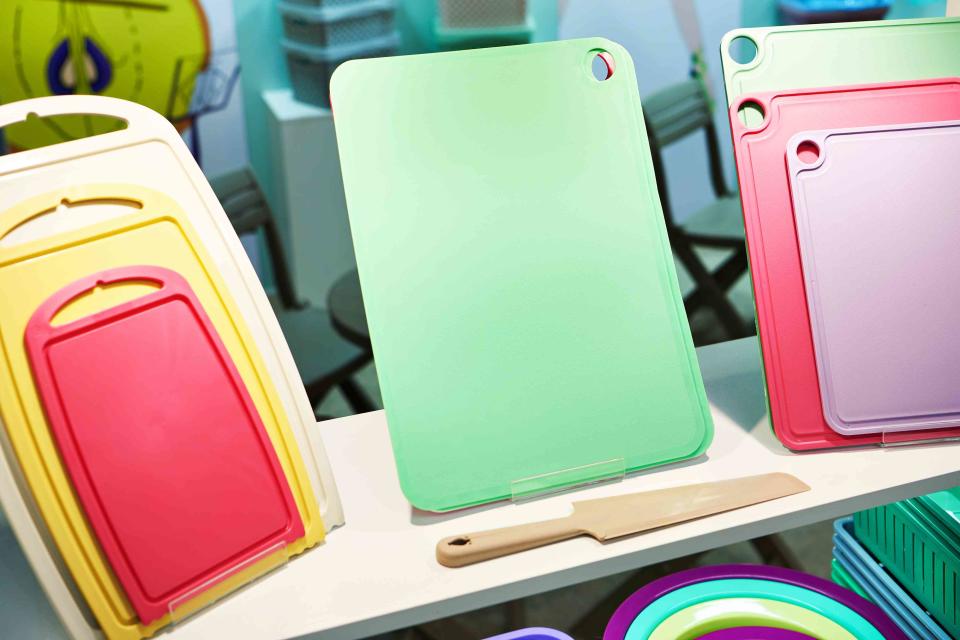Here’s Why You Should Probably Stop Using Your Plastic Cutting Board
They are a 'potentially significant source of microplastics in human food,' according to a recent study.

sergeyryzhov / Getty Images
The most dangerous item in your kitchen may not be sharp, hot, or fragile.
According to recent research, the commonly used plastic cutting board may pose a major health hazard. A peer-reviewed study published in the journal Environmental Science & Technology found that the boards may, in fact, lead to significant amounts of microplastic in our food.
Titled “Cutting Boards: An Overlooked Source of Microplastics in Human Food?” the research concluded that chopping ingredients, like vegetables, on two specific types of plastic boards, polyethylene and polypropylene, releases microplastics that can cling to the food we eat. And it’s not just vegetables. A 2022 study found that chopping on these boards releases microplastics into meat and a similar study found that microplastics can be found on fish, chicken, and meat purchased at markets that use plastic boards.
Related: 5 Ways You're Ruining Your Wood Cutting Board (and How to Stop)
This may come as no surprise to anyone who has used a plastic cutting board, proudly scuffed and engraved with the knife marks of a proud cook. Well, those indentations are remnants of where the plastic used to be, converted into tens of millions of microplastic particles.
Microplastics are generally considered to be a hazard, but what are they? Microplastics are tiny plastic pieces, less than 5 millimeters in diameter, that can take hundreds or thousands of years to decompose. In the meantime, they’re polluting the environment — having been found in the clouds, air, water, soil, and sand — and they’re contaminating our bodies.
Microplastics have been found in humans’ bloodstreams, lungs, and beyond and there’s no proven scientific way to rid them from the human body. Though medical studies are still emerging, we know that these toxins aren’t benefiting our health. Microplastics have been linked to harming the human body as a source of toxic chemicals, and they’re connected to various cancers and disorders. In fact, a study from 2023 suggests that the patients with microplastics found in their arterial plaque "had a higher risk of a composite of myocardial infarction, stroke, or death from any cause at 34 months of follow-up than those in whom MNPs [microplastics and nanoplastics] were not detected."
Plastic cutting boards are hardly the only commonly used kitchen items that create microplastics. Dishwasher detergent pods are a well-known source of microplastic pollution. Containers —including food packaging, leftover containers, ice trays, and plastic bags — can also release microplastics, or nanoplastics (an even smaller version of microplastic that is invisible to the human eye). Just twisting the cap of a bottle can unleash microplastics into the environment and your beverage. Ordering takeout packaged in plastic can also up your microplastic consumption. It’s a plastic world out there.
Related: How to Stabilize Your Cutting Board With a Wet Towel
So how can we avoid these omnipresent plastics? Being conscious about which materials we bring into our homes and kitchen is the best way. Switching to a wooden cutting board — we have a few suggestions — can help omit the microplastics in your prep work. Packaging leftovers in glass or metal containers is also a better option for sustainable food storage. You can also switch to eco-friendly powder dish detergent, often packaged in compostable cardboard, and shop at farmer’s markets or other sustainable produce sources that nix the plastic packaging in favor of paper or reusable bags.
But before you throw your plastic cutting board with the trash, check the bottom for any recyclable markings. Then say goodbye, and get ready for a new life of chic wooden cutting boards. Just don’t forget to season it!
For more Food & Wine news, make sure to sign up for our newsletter!
Read the original article on Food & Wine.